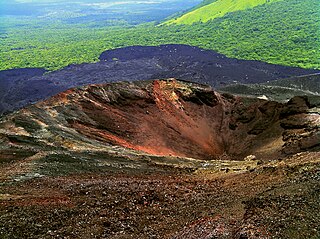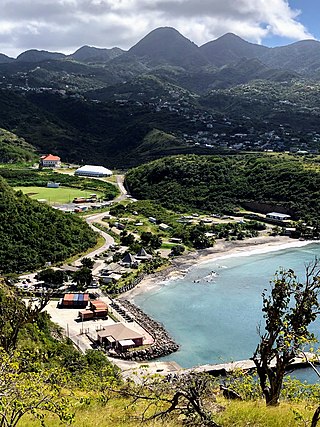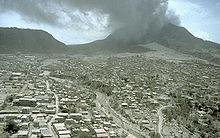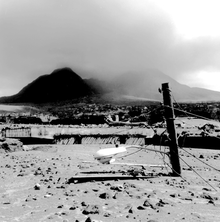
Montserrat is a British Overseas Territory in the Caribbean. It is part of the Leeward Islands, the northern portion of the Lesser Antilles chain of the West Indies. Montserrat is about 16 km (10 mi) long and 11 km (7 mi) wide, with roughly 40 km (25 mi) of coastline. It is nicknamed "The Emerald Isle of the Caribbean" both for its resemblance to coastal Ireland and for the Irish ancestry of many of its inhabitants. Montserrat is the only non-fully sovereign full member of the Caribbean Community and the Organisation of Eastern Caribbean States.

Montserrat is an island in the Caribbean Sea, in the Leeward Islands. Its nearest neighbours in the island chain include Guadeloupe to the southeast, Antigua to the north-east and Nevis to the northwest. The island is 16 km (9.9 mi) long and 11 km (6.8 mi) wide, with a coastline of about 40 km.

The economy of Montserrat was severely disrupted by volcanic activity which began in July 1995. Prior to this date, the small island country of 12,000 had an export economy based on agriculture, clothing, electronic parts and plants, with a per capita gross national product of US$3,000 to 8,000.

A pyroclastic flow is a fast-moving current of hot gas and volcanic matter that flows along the ground away from a volcano at average speeds of 100 km/h but is capable of reaching speeds up to 700 km/h. The gases and tephra can reach temperatures of about 1,000 °C (1,800 °F).

Mount Pelée or Mont Pelée is an active volcano at the northern end of Martinique, an island and French overseas department in the Lesser Antilles Volcanic Arc of the Caribbean. Its volcanic cone is composed of stratified layers of hardened ash and solidified lava. Its most recent eruption was in 1932.

Mount Unzen is an active volcanic group of several overlapping stratovolcanoes, near the city of Shimabara, Nagasaki on the island of Kyushu, Japan's southernmost main island.

The Soufrière Hills are an active, complex stratovolcano with many lava domes forming its summit on the Caribbean island of Montserrat. After a long period of dormancy, the Soufrière Hills volcano became active in 1995 and has continued to erupt ever since. Its eruptions have rendered more than half of Montserrat uninhabitable, destroying the capital city, Plymouth, and causing widespread evacuations: about two-thirds of the population have left the island. Chances Peak in the Soufrière Hills was the highest summit on Montserrat until the mid-1990s, but it has since been eclipsed by various rising and falling volcanic domes during the recent volcanic activity.

In volcanology, a lava dome is a circular, mound-shaped protrusion resulting from the slow extrusion of viscous lava from a volcano. Dome-building eruptions are common, particularly in convergent plate boundary settings. Around 6% of eruptions on Earth are lava dome forming. The geochemistry of lava domes can vary from basalt to rhyolite although the majority are of intermediate composition The characteristic dome shape is attributed to high viscosity that prevents the lava from flowing very far. This high viscosity can be obtained in two ways: by high levels of silica in the magma, or by degassing of fluid magma. Since viscous basaltic and andesitic domes weather fast and easily break apart by further input of fluid lava, most of the preserved domes have high silica content and consist of rhyolite or dacite.

Cerro Negro is an active volcano in the Cordillera de los Maribios mountain range in Nicaragua, about 10 km (6.2 mi) from the village of Malpaisillo. It is a very new volcano, the youngest in Central America, having first appeared in April 1850. It consists of a gravelly basaltic cinder cone, which contrasts greatly with the surrounding verdant hillsides, and gives rise to its name, which means Black Hill. Cerro Negro has erupted frequently since its first eruption. One unusual aspect of several eruptions has been the emission of ash from the top of the cone, while lava erupts from fractures at the base.

La Soufrière or Soufrière Saint Vincent is an active volcano on the Caribbean island of Saint Vincent in Saint Vincent and the Grenadines. It is the highest peak on Saint Vincent, and has had eight recorded eruptions since 1718. The latest eruptive activity began on 27 December 2020 with the slow extrusion of a dome of lava, and culminated in a series of explosive events between 9 and 22 April 2021.

A Vulcanian eruption is a type of volcanic eruption characterized by a dense cloud of ash-laden gas exploding from the crater and rising high above the peak. They usually commence with phreatomagmatic eruptions which can be extremely noisy due to the rising magma heating water in the ground. This is usually followed by the explosive clearing of the vent and the eruption column is dirty grey to black as old weathered rocks are blasted out of the vent. As the vent clears, further ash clouds become grey-white and creamy in colour, with convolutions of the ash similar to those of Plinian eruptions.

Brades is a town and the de facto capital of Montserrat since 1998 with an approximate population of 1,000.

W.H. Bramble Airport, formerly known as Blackburne Airport, was an international airport on the east coast of the island of Montserrat, a British Overseas Territory in the Caribbean. It was named after Montserrat Chief Minister William Henry Bramble.
Radio Antilles was a radio station operated by the Antilles Radio Corporation which began broadcasting in 1963. It was located on the British Caribbean island of Montserrat.

The following outline is provided as an overview of and topical guide to Montserrat:

Music for Montserrat was a benefit concert held on 15 September 1997 at the Royal Albert Hall. The event was organised by Sir George Martin, former producer for The Beatles and founder of Associated Independent Recording, to raise funds for the Caribbean island of Montserrat after a major volcanic eruption by the Soufrière Hills volcano earlier that year.

Little Bay is a port town under construction which is intended to be the future capital of the island of Montserrat, a British Overseas Territory in the Caribbean. It is adjacent to the town of Brades, where government headquarters are currently located.

The 2018 Volcán de Fuego eruption was an eruption of Volcán de Fuego in Guatemala on Sunday 3 June 2018. The eruption produced a large ash plume fed by continuous explosions, pyroclastic flows, and lahars. Pyroclastic flows descended the Las Lajas ravine and overspilled its confines, causing the death of officially nearly 200 people. This was the deadliest eruption in Guatemala since the eruption of Volcán Santiaguito in 1902.

La Soufrière, a stratovolcano on the Caribbean island of Saint Vincent in Saint Vincent and the Grenadines, began an effusive eruption on 27 December 2020. On 9 April 2021 there was an explosive eruption, and the volcano "continued to erupt explosively" over the following days, with pyroclastic flows. The activity pattern of the eruption was comparable to that of the event that occurred in 1902, which had a Volcanic Explosivity Index (VEI) of 4. The volcano is known to have erupted 23 times in the last 4,000 years, and had been dormant since 1979.

In early January 1951, a series of minor explosions and earthquakes rocked Mount Lamington, a volcano in Oro Province, Territory of Papua and New Guinea. Prior to the eruption, Mount Lamington was not recognized as a volcano due to the absence of historically-recorded eruptions and dense vegetation cover. From January 15, volcanic activity intensified, and tall eruption plumes were generated. The largest eruption occurred on the morning of January 21 when a thick black plume of ash rose 15,000 metres (50,000 ft) into the atmosphere. The eruption collapsed a lava dome and produced a lethal pyroclastic flow that killed 2,942 people. In the years after the eruption, new lava domes formed and collapsed in succession. Activity persisted until July 1956. The eruption is the deadliest natural disaster in Australian history, as the region was under the rule of the Government of Australia.





























